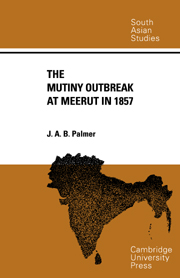Book contents
- Frontmatter
- Contents
- Introduction
- 1 CHAPĀTĪS
- 2 GREASED CARTRIDGES
- 3 THE PRESIDENCY DIVISION, FEBRUARY TO MAY
- 4 REGIMENTS AND OFFICERS AT MEERUT
- 5 MEERUT CANTONMENT IN 1857
- 6 THE FIRING PARADE OF 24 APRIL AND ITS SEQUEL
- 7 THE OUTBREAK: (a) The Native Infantry Lines
- 8 THE OUTBREAK: (b) The Native Cavalry Lines
- 9 THE OUTBREAK: (c) The Bazar Mobs
- 10 THE OUTBREAK: (d) The European Troop Movements and the European Lines
- 11 THE HANDLING OF THE EUROPEAN TROOPS
- 12 TO DELHI
- 13 CONCLUSIONS
- Notes and References
- Index
- Plan of Meerut Cantonment in 1857
5 - MEERUT CANTONMENT IN 1857
Published online by Cambridge University Press: 24 October 2009
- Frontmatter
- Contents
- Introduction
- 1 CHAPĀTĪS
- 2 GREASED CARTRIDGES
- 3 THE PRESIDENCY DIVISION, FEBRUARY TO MAY
- 4 REGIMENTS AND OFFICERS AT MEERUT
- 5 MEERUT CANTONMENT IN 1857
- 6 THE FIRING PARADE OF 24 APRIL AND ITS SEQUEL
- 7 THE OUTBREAK: (a) The Native Infantry Lines
- 8 THE OUTBREAK: (b) The Native Cavalry Lines
- 9 THE OUTBREAK: (c) The Bazar Mobs
- 10 THE OUTBREAK: (d) The European Troop Movements and the European Lines
- 11 THE HANDLING OF THE EUROPEAN TROOPS
- 12 TO DELHI
- 13 CONCLUSIONS
- Notes and References
- Index
- Plan of Meerut Cantonment in 1857
Summary
A knowledge of the topography of Meerut Cantonment in 1857 is essential for any understanding of the events of 10 May or of the depositions and narratives relating to those events. The sources from which the topography in 1857 can, to a great extent, be recovered are descriptions by various writers and a few surviving maps.
Descriptions actually contemporary with the Mutiny are those of Mrs Muter, Surgeon O'Callaghan, and an anonymous document printed in Chick. The American traveller Minturn gives a brief account of the place in the preceding year, 1856. It is also very worth while reading the much fuller account of Meerut and its ways of life presented by Thomas Bacon twenty years earlier.
In England at any rate, there does not appear to survive any copy of a full map of Meerut prior to 1857 and there is only one partial sketch map dating from 1857, which is preserved among the Kaye Papers in the India Office: it shows the Dam-damma or Artillery School of Instruction, where the European population took refuge after the outbreak, and part of the northern face of the European lines. It was prepared by Lieutenant E. Jones of the Bengal Artillery to show the temporary defences of the Dam-damma, but it furnishes some interesting details.
Next, and much the most important, is a map prepared in 1860 from actual survey by Lt.-Col. F. Alexander, the Executive Engineer at Meerut, on the scale of one mile to eight inches.
- Type
- Chapter
- Information
- The Mutiny Outbreak at Meerut in 1857 , pp. 47 - 57Publisher: Cambridge University PressPrint publication year: 1966



